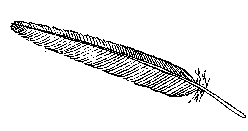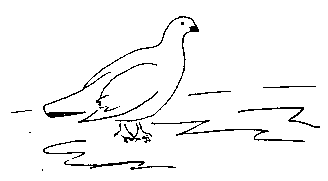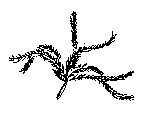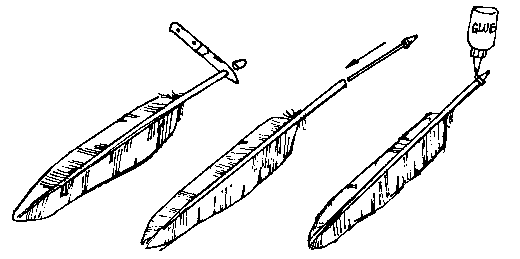Lessons & Units
A database
of lessons and units searchable by content and cultural standards,
cultural region and grade level. More units will be available soon.
You can use Acrobat Reader to look at the PDF version of the Cover
Sheet
for the Units and Self-Assessment
for Cultural Standards in Practice.
BIRDS
|
Lesson 2 Feathers
|

|
Objectives: 1) Students will know the different types of feather a
bird has and the function of each.
2) Students will describe the construction of a feather.
3) Students will describe the insulating quality of
feathers.
Materials: feathers, microscope and/or hand
lenses
Activities:
1) Feathers are something no other
animals have. Discuss the purpose of feathers. Why do we sometimes
say something is "light as a feather"? Have each student draw
a feather. Label the main parts: quill, shaft and vane.
2) Look at the feathers brought in by students.
a. Are there different types? Can you guess what part
of the bird it came from and what its function is? (contour,
flight, down and after-feathers; see Alaska 's Birds,
pg. 2-3)
b. Compare the same type of feathers from different birds.
Measure some feathers. Which is the longest one you have? Which
is the smallest? Relate the size to the type of feather and
kind of bird it's from.
b. Are there different colors of feathers? Discuss the
reasons birds have feathers of different colors.
3) Select a large contour feather
and a flight feather.
a. Look at the vanes on these two feathers. How can
YOU tell them apart? (The vane on the flight feather is
wider on one side than on the other.)
b. Look at the quill. Is it solid or hollow? Why?
c. Look at the vane closely with a microscope. Can you see
the little barbs? Split the vane and then smooth it with your
fingers to see how it zips back up. A bird can do this with its
beak. Of what advantage is this?
d. Split the shaft into several sections. People used to
make snares out of split shafts from some of the larger birds
like swans. ("Bird Traditions...", pg. 18)
4) Compare down feathers to contour feathers.
a. Look at a down feather with a hand lens. Try to
smooth it down as you did the larger feather. Do the barbs on
the vane stick together?
b. Look at the shaft on a down feather. How does it compare
to that of a contour feather? (shorter, thinner, more
flexible) How are these differences related to the function
of the feather? Why does a bird sometimes "fluff up" its
feathers?
5) Feathers are important in keeping birds warm. People
use down clothing and sleeping bags to keep out the cold. Ask the
elders about using feathers for insulation.
Experiment with the insulating quality of feathers. Then
discuss why feathers are good insulation.
- Select something filled with feathers
(hat, bag...) and two other things
made from different types of materials such as wool, paper,
or plastic. Speculate as to which is the best insulation.
Make three pieces of toast at the same time and put one
inside the feather container and one each in two other types
of insulating material. Check the toast in 3 minutes and see
which piece is warmer.
- Use feathers and two other kinds of insulating material
and wrap up three thermometers. Put your experiment outside
for five minutes and check the temperatures. What happens if
you leave them out for a longer time? Use a fourth
uninsulated thermometer if you want to see how much heat is
saved by the insulation. Make a chart to show your
results.
6) Make a feather collection for the classroom. Indicate
a) which bird it is from
b) which type of feather it is
7) Experiment with making feather pens. (See instructions on
page following.) Try different kinds of feathers to find which
work best. Try different angles of cuts. Record the data and draw
conclusions as to how to make the best feather pen. Write your own
set of instructions.

from ALASKA'S
BIRDS
Types of Feathers:
Let's take a closer look at the one
thing no animals other than birds have--feathers! Feathers keep birds
warm, camouflage them from predators, allow them to fly, and attract
mates. But all feathers are not the same. Here are a few of the
different types of feathers:
|

|
Contour feathers cover a bird's
body, streamlining it for flight and keeping the bird warm
and dry. Though they appear to cover the entire body,
contour feathers grow only in patches, called pterylae, on
most birds' bodies. Contour feathers have a vane, a shaft,
and a quill. The vane is held together by thousands of tiny
barbs. If the vane splits, the bird can "zip" it back up by
pulling it through his beak. To preen its feathers, a bird
first oils its bill at a special oil gland found at the base
of the tail, and then by pulling individual feathers through
its oily beak, each feather is "zipped up" and waterproofed.
A bird must preen its feathers often in order to stay warm
and dry, and in order to fly.
|
|

|
Flight feathers are the long
feathers on the wings and tail used in flying. Wing flight
feathers can be easily identified because the shaft does not
divide the vane evenly.
|
|
Down feathers are the small fluffy
feathers found under the contour feathers. What do people
use down for? Birds use their down to keep warm, too.
Sometimes birds fluff up their feathers which makes them
look fat. Birds do this to create air spaces between the
feathers. These spaces hold air heated by the body which
provides insulation from the cold.
|

|
|

|
After-feathers are small feathers that
emerge from the same shaft as a contour feather. Best seen
on grouse and ptarmigan, after-feathers help insulate the
bird and fill out body contours.
|
From BIRD TRADITIONS...
Feather Technology
The Inland Dena'ina recognize at least four kinds of feathers: the
very soft under feathers (down feathers), the tiny hair-like pin
feathers (filoplumes), the stiff wing and tail feathers (flight
feathers), and the remaining body feathers (contour feathers). Some
people recognize the head feathers as a separate category. Following
is an account of the upper Stony River Dena'ina feather technology
except the feather clothing described in Bird Clothing.
Flight feather shafts of eagles, swans, cranes, cormorants, gulls,
and other birds with strong shafts have been used to make snares,
fishing equipment, and other items. Although eagles feathers are said
to be the strongest, gull feathers appear to have been most commonly
employed because they are both strong and easily accessible. Besides
their strength, feather shafts are valued for being flexible, light
weight, and waterproof. An elder describes them as having the
qualities of plastic. They can be used either fresh or dried.
Lime Village people have made technological items from fresh or
dried feather shafts by removing the barbs which make up the vane of
the feather and splitting the shaft lengthwise to the desired width.
To split a shaft, a small cut is made in one end of the shaft. The
shaft is separated by holding one part of the shaft by the teeth and
pulling slowly down by hand on the other section. The marrow is then
removed from the shaft.
Bird, fish, ground squirrel, and other small
animal snares have been made from feather shafts. Using a
special knot, dipnets, set
nets, "gunny sack" nets, and scoops for harvesting fish have been
woven from feather shafts. "Gunny sack" nets have served as part of
both beaver and fish traps. For all items, elders emphasize the
importance of making the correct knot well. The distance between
knots determines the mesh size and thus the type of prey caught in
the net.
Although weaving nets and scoops with feather shafts is
considerably more time consuming than making them from other
material, their long life and light weight is said to be worth the
extra time. Ideally nets and other items made from multiple feather
shafts consist of one species of feather shaft. However, if enough of
one species is not available, the item can be made from several or
more species of feathers shafts.
Miscellaneous uses for feather shafts have included thread for
sewing birch bark canoes, although spruce roots have been preferred.
Birch bark baskets have been decorated by weaving them with dyed
feather shafts. Red and black ocher provide the best dyes for
feathers because they are said to be more durable than berry
dyes.
Straight wing or tail feathers of large birds have been attached
to arrow shafts so that the arrows fly straight. The water resistant
feathers of waterbirds including those of cormorants have been used
for hunting waterbirds, and during rain, land birds. Large land bird
feathers such as eagle feathers have been employed for hunting land
birds in dry conditions. The feathers of gray jays and magpies, for
example, are too small. Both the feathers and points have been tied
with sinew to the arrow shaft (see Birds for more information on
arrow use and technology).
The wings of ducks, geese, and other large birds have been used as
sweeping tools (brooms).
Eagle Feathers have been worn on the headdresses of singers at
potlatches and possibly by warriors. Shamans have worn feather
headdresses (Kari 1977:239). Brown bear skin headbands held bald
eagle, golden eagle feathers, or a combination of the two kinds of
feathers. Although golden eagle feathers are harder to obtain than
bald eagle feathers because golden eagles live in the mountains, the
two types are said to have equal value.
From BIRDS
AND WETLANDS OF ALASKA
Make a Feather Pen
In the past, people used
feathers to make writing pens. These were called quill pens, and they
were filled by dipping the sharpened tip into a bottle of ink. To
make a quill pen, find a feather with a strong shaft (try looking at
the beach or near a pond). You'll also need a sharp knife and a
bottle of ink or thin paint. Cut the tip of the shaft at an angle.
Then cut a slit in the tip so that the ink will spread when you write
with it. Dip the pen into the ink and try writing.

It may be hard to make a quill
pen that works well because the angle has to be just right to get the
ink to flow evenly. But it is easy to make a fake quill pen using a
ballpoint pen filler point. To do this, cut the tip of your feather
straight across with a scissors or knife. Push the filler point up in
the feather with the point sticking out about half an inch. Dab a bit
of glue on the filler where it touches the feather.

Handbook
for Culturally Responsive Science Curriculum by Sidney Stephens
Excerpt: "The information and insights contained in this document will be
of interest to anyone involved in bringing local knowledge to bear in school
curriculum. Drawing upon the efforts of many people over a period of several
years, Sidney Stephens has managed to distill and synthesize the critical ingredients
for making the teaching of science relevant and meaningful in culturally adaptable
ways." |